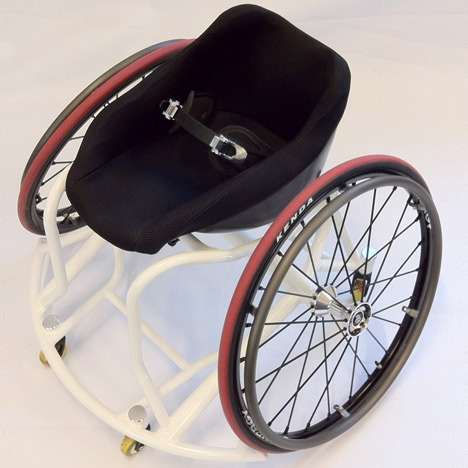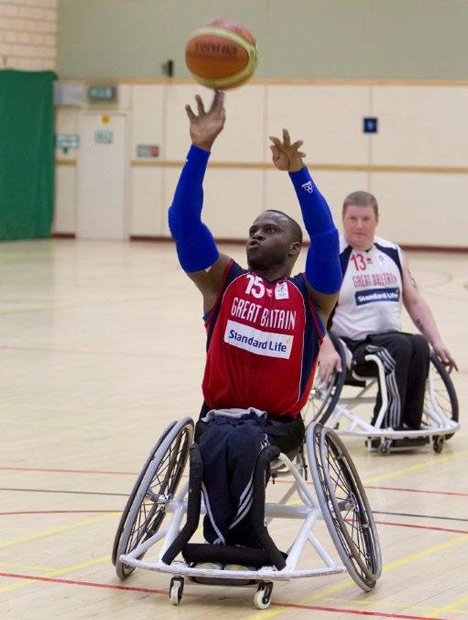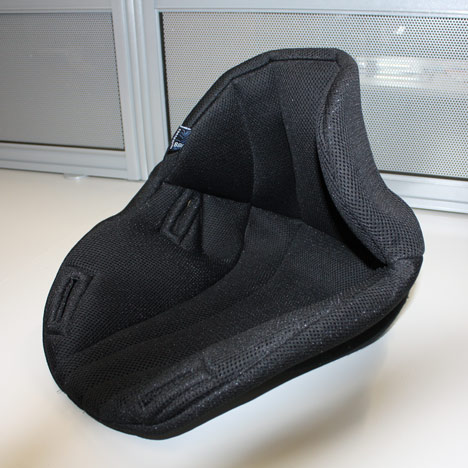
Paralympic design: 3D-printed seats for wheelchair basketball
The first tailor-made 3D printed seats for wheelchair basketball are being used by competitors at the London 2012 Paralympics.

Developed by Loughborough University’s Sports Technology Institute alongside UK Sport, the seats are individually moulded each player's body.

The customised seats consist of foam interiors and plastic shells, and are a kilogram lighter than conventional wheelchair basketball seats.

Participating athletes had 3D body scans to capture their movements and positions in their existing wheelchairs, then CAD technology was used to shape the outer layer of the seat to suit each individual player and help position the seat onto the frame. The seats were then built up layer by layer using selective laser sintering to accurately replicate the computer models. Four men and four women will use the seats at this year's Paralympic Games.
The wheelchair basketball finals take place on Friday 7 and Saturday 8 September at the Basketball Arena and the North Greenwich Arena.
We've also featured wheelchairs designed to withstand heavy impacts for rugby and to be fast and lightweight for racing. See all our stories about design for Paralympic athletes »
Here is some more information from the Engineering and Physical Sciences Research Council:
Innovative tailor-made seats will be used for the first time by Paralympics GB for the wheelchair basketball events this summer.
Using cutting-edge research the seats are individually moulded for each player to provide the best possible support. They will help the athletes to improve their speed, acceleration and manoeuvrability around the court.
The seats have been developed with UK Sport funding at Loughborough University’s Sports Technology Institute, which is supported by the Engineering and Physical Sciences Research Council (EPSRC).
The new seats are revolutionary because they take the individual’s size, shape and particular disability into account. For example, a player with a spinal cord injury will have a seat that provides additional support around their lower back.
Harnessing a range of cutting-edge design and manufacturing techniques and developed in close consultation with the British men’s and women’s wheelchair basketball teams, these customised seats consist of a foam interior and a plastic shell. They are simply clamped onto the current wheelchair design in which the frames are already made to measure for the players.
You can find out more about the research from the team involved in an audio slide show.
“Within any wheelchair basketball team, both the nature and the extent of the players’ physical abilities vary considerably,” says Dr Gavin Williams, who has led the project.
“Traditionally players have had a very limited choice of seat designs and a tailor-made approach was not possible. The new seats, which include part of the back rest, are made specifically to accommodate each individual’s needs”.
Team members initially underwent 3D scans to capture their bodies’ biomechanical movements and their positions in their existing wheelchairs.
The seats are made up using cutting-edge design and manufacturing techniques
A moulding bag containing small polystyrene balls (similar to a bean bag style seat), was used to capture the shape of the player when seated. The seat was then made up by hand.
Computer-aided design (CAD) capabilities were then used to refine the shape of the outer layer of the seat to suit each individual player and help position the seat onto the frame.
Using this prototype the next stage involved quickly producing copies of each individual seat so that they could be further tested and amended if necessary following feedback. For this speedy production an additive manufacturing technique called selective laser sintering (otherwise known as 3D printing) was used to build up each seat layer by layer. This resulted in a final product that exactly replicated what was on the computer screen.
This is the first time anywhere in the world that these existing techniques have been harnessed together to produce a sports wheelchair seat.
Improvements in speed, acceleration and manoeuvrability for the players were achieved.
“The sprint tests, for instance, showed that the new seats enabled the athletes to shave tenths of a second off their best times,” says Dr Williams. “That represents a huge improvement in a player’s ability to reach the ball and move around the court.
The seats save a kilo of weight with the overall chair being two kilos lighter than the chairs that were used in Beijing because of other modifications to the chair itself.
“The advances we’ve made also have the potential to feed into improved seat design for wheelchair users in general,” says Dr Williams. “In particular, bespoke seats could reduce the problems with pressure sores currently experienced by a great number of wheelchair users.”
In total 8 players, four men and four women will be using the new seats at the Paralympics this year.